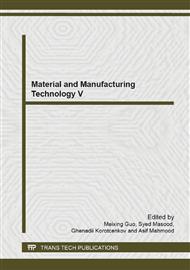p.220
p.225
p.230
p.235
p.241
p.247
p.252
p.257
p.262
Evaluation of Mixed Cellulase-Amylase System on Enzymatic Hydrolysis Reaction Using Response Surface Methodology
Abstract:
The ability of mixed enzyme (ɑ-amylase and cellulase) immobilized via cross-linking method with 3% of glutaraldehyde (GA) on polymeric membrane containing 20 wt% of polysulphone and 80 wt% of 1-methyl-2-pyrrolidone (NMP)/polyvinylpyrrolidone (PVP) to catalyze the complex structure (starch and cellulose) into glucose was investigated in this study. Central Composite Face Centered Design (CCFD) with alpha equal to 1 (ɑ=1) were used to evaluate the effects of pH, temperature, percent of enzyme dosage and percent of substrate concentration on enzymatic hydrolysis process. Maximum glucose concentration (g/L) was obtained at 50°C, pH 6.5, 3% of enzyme dosage and 3% of substrate concentration. The study indicated that only substrate and enzyme ratio play significant role (P < 0.1) in maximizing glucose production within pH, temperature, substrate and enzyme dosage range of pH5-8, 30-70°C, 1-5w/v%, and 1-5w/v% respectively. Kinetic enzyme using Lineweaver-Burk plotting suggested that Km and Vmax for the mixed enzyme in this process were 9.6 g/L and 0.3571 U/mg respectively.
Info:
Periodical:
Pages:
241-246
Citation:
Online since:
June 2014
Price:
Сopyright:
© 2014 Trans Tech Publications Ltd. All Rights Reserved
Share:
Citation:


